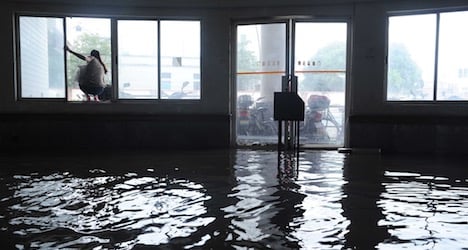The report from the United Nations agency for disaster risk reduction (UNISDR) said floods, storms and other extreme weather events have killed 606,000 people since 1995, “with an additional 4.1 billion people injured, left homeless or in need of emergency assistance.”
The report noted that while there was no way to establish how much of the rise in such disasters was caused by climate change, the link between the planet's changing climate and extreme weather was clear.
“The contents of this report underline why it is so important that a new climate change agreement emerges from the COP21 in Paris”, said UNISDR chief Margareta Wahlstrom, referring to crunch climate talks starting next week.
The talks that open in the French capital on November 30 are tasked with crafting a 195-nation pact to curb greenhouse gas emissions blamed for dangerous levels of climate change.
Between 2005 and 2014, the leading database that tracks weather-linked disasters recorded 335 such incidents, a 14 percent increase compared to the previous decade and nearly double the number recorded from 1985 to 1994.
Overall, the report said, the planet has seen “a sustained rise in the numbers of floods and storms”, noting that drought, heatwaves and extreme cold were also growing concerns.
According to UNISDR data, flooding accounted for 47 percent of all weather disasters over the last 20 years, affecting more than 2.3 billion people, the vast majority of whom live in Asia.
A full 75 percent of the 4.1 billion people affected were in either China or India, underscoring the extent to which densely populated areas in those countries were disproportionately vulnerable.
Next in line in terms of the number of people affected over the reporting period were Bangladesh (131 million people) and the Philippines (130 million people), while Brazil (51 million people) led the way in the Americas and Kenya was the most affected country in Africa (47 million people).
The report also detailed the heavy damage to property and infrastructure inflicted by extreme weather.
This includes 87 million homes damaged or destroyed, with hundreds of thousands of schools, hospitals and other key facilities affected worldwide.
In total, UNISDR data counted $1.9 trillion (€1.8 trillion in financial losses attributable to extreme weather events.
Given the correlation between climate change and extreme weather, the planet will “witness a continued upward trend in weather-related disasters in the decades ahead,” the report warned.
WEATHER
Climate deal could cut weather disasters: UN
Weather-related disasters have grown more frequent over the last 20 years, claiming more than 600,000 lives, a Geneva-based UN agency said on Monday, issuing a further call for nations to strike a landmark deal on climate change.
Published: 23 November 2015 11:47 CET

Woman squats in window of flooded hall after heavy rains in Shanghai in August. Photo: STR/AFP
Url copied to clipboard!



 Please whitelist us to continue reading.
Please whitelist us to continue reading.
Member comments